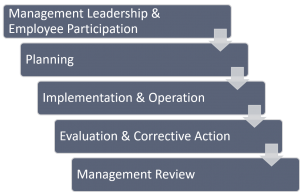
Safety Management Systems
Reduce Operational Costs
A world class model for the development and implementation of an effective safety and health management system has been developed based on the quality management systems standards produced by the International Organization for Standardization, commonly known as ISO. These standards have been used throughout the world to develop effective safety management programs based on a clearly defined standard for safety management systems.
Safety & Health Management Systems are comprised of five main elements:
- Management Leadership & Employee Participation: management establishes policy and directs the development of the safety and health management system with the direct and meaningful involvement of employees.
- Planning: working together, management and employees identify hazards and risks, identify deficiencies in the management system, prioritize issues, develop objectives, and formulate a plan to achieve objectives.
- Implementation & Operation: the core of an effective safety and health management system is the development of a process for risk assessment and control that identifies the nature of hazards and the level of risk involved with operational activities and provides a systematic method for reducing risks to an acceptable level.
- Evaluation and Corrective Action: continuous improvement requires the monitoring, measurement, and assessment of the risk assessment and control process and the effectiveness of corrective and preventive actions.
- Management Review: establishes a process for reviewing the adequacy and effectiveness of the safety and health management system.
These five element of an effective Safety & Health Management System must be reviewed or audited on a continuous basis to make sure that all element of the system are having the desired effect on reducing injuries and the cost of injuries.
Safety & Health Management System Audit
Improvement of your organizational safety management system will not only improve safety performance, it will also help to build trust, improve organizational capacity for change, and develop the skills required to effectively manage other aspects of organizational performance using the principles of quality management.
Conducting the Audit
The International Organization for Standardization (ISO) has developed several management system standards that are used to establish control processes for organizations. These standards are based on the recognized principles of quality management. Auditing management systems is the principle method used to determine the effectiveness of these control processes. The standard used as the audit criteria for Safety Management Systems is ANSI Z10 2012 (R2017) Occupational Health and Safety Management Systems. This standard helps to determine if high risk organizations are effectively able to manage risk and still achieve operational objectives.
The guiding principles for the SMS audit include:
- Integrity
- Fair presentation
- Due professional care
- Confidentiality
- Independence
- Evidence-based approach
The activities involved in the SMS audit include:
- Establishing audit procedures and methodologies
- Selecting audit personnel and defining roles and responsibilities
- Defining objectives, criteria and scope for each audit
- Ensuring the audit results are communicated
The general steps included in the SMS audit include:
- Initiating the audit
- Preparing for audit plan
- Conducting the audit
- Preparing the audit report
- Reviewing the audit process
- Developing a plan for SMS improvement
Safety Management Systems
Contact us to talk about working with your staff to improve your safety management systems.